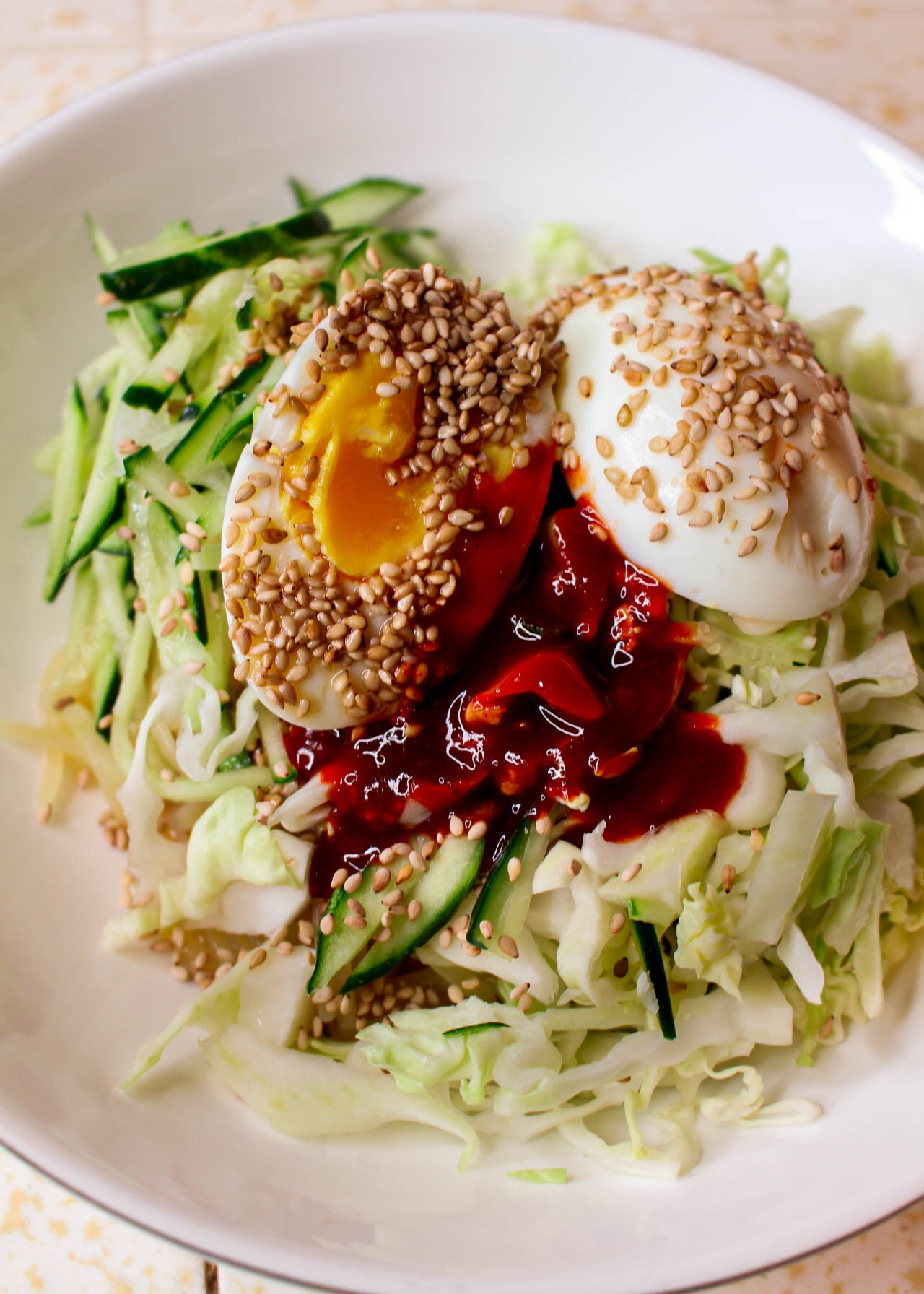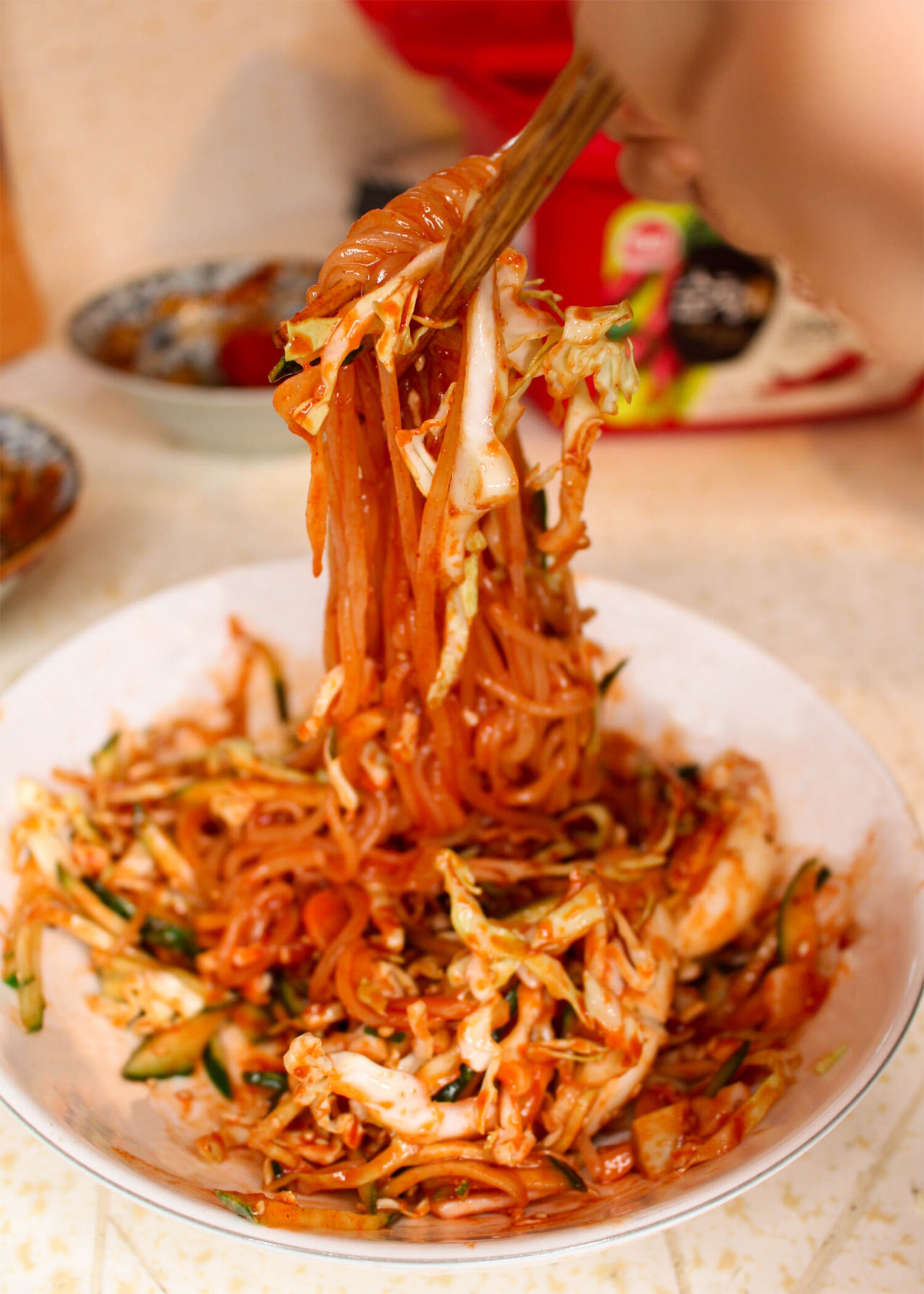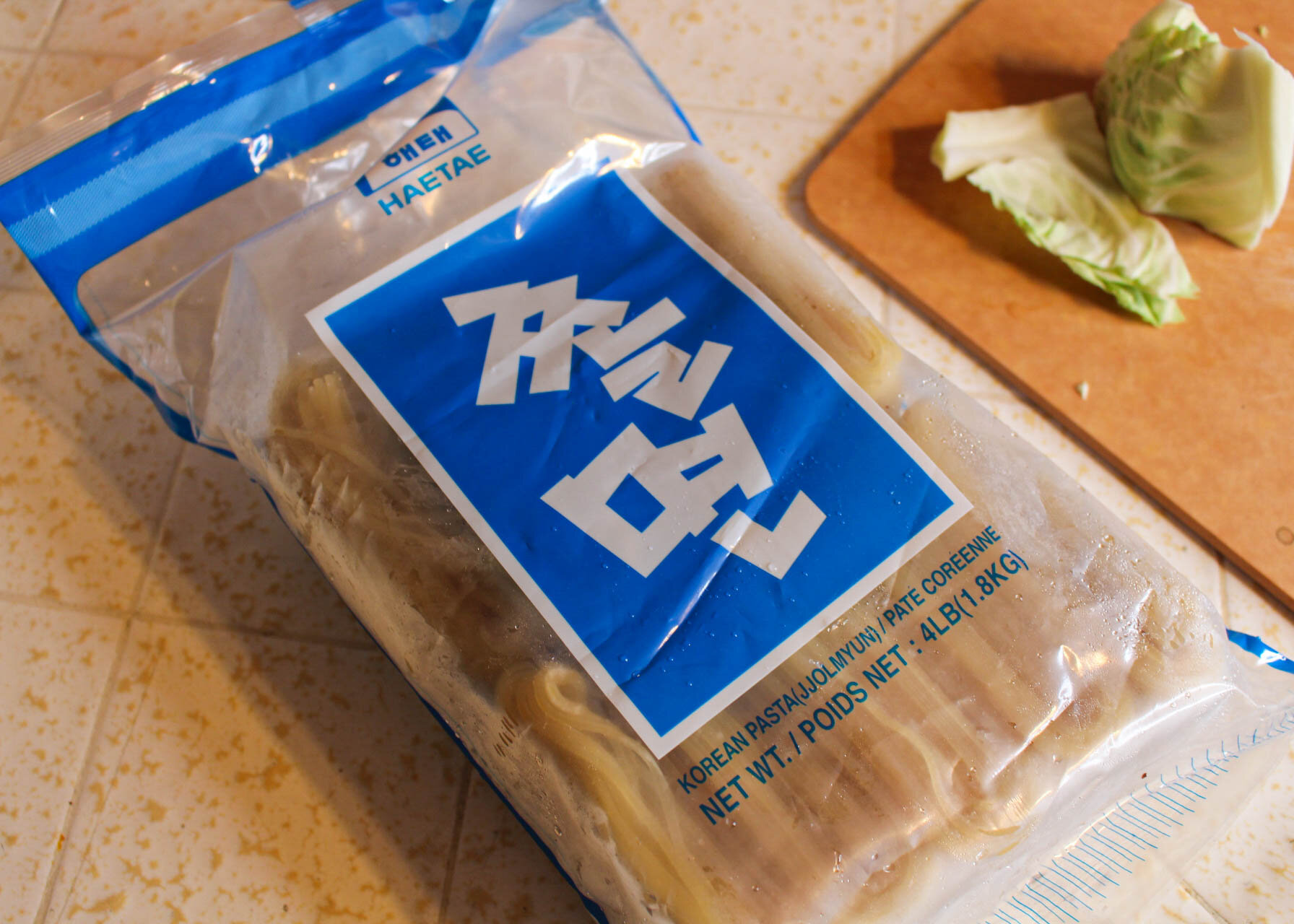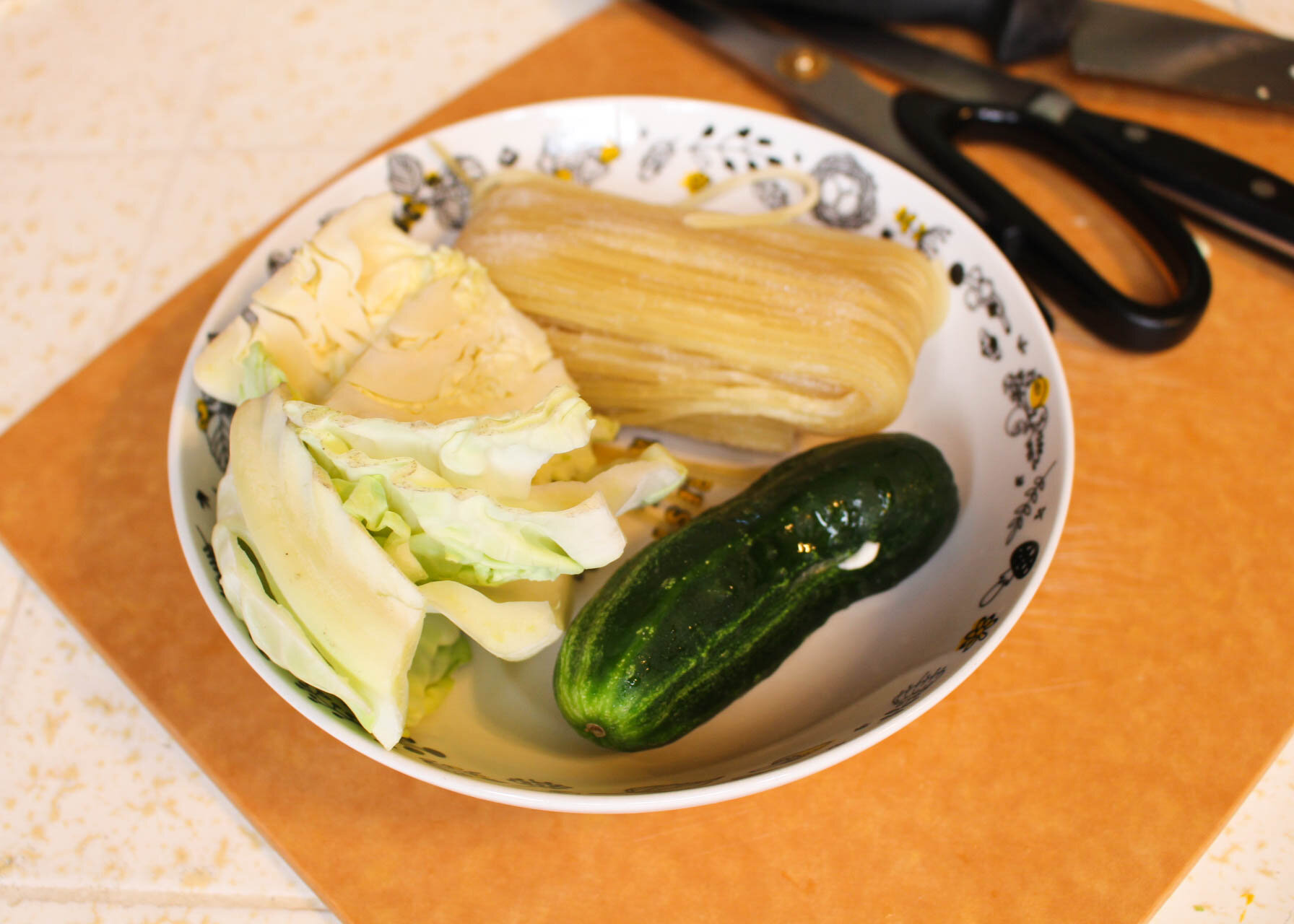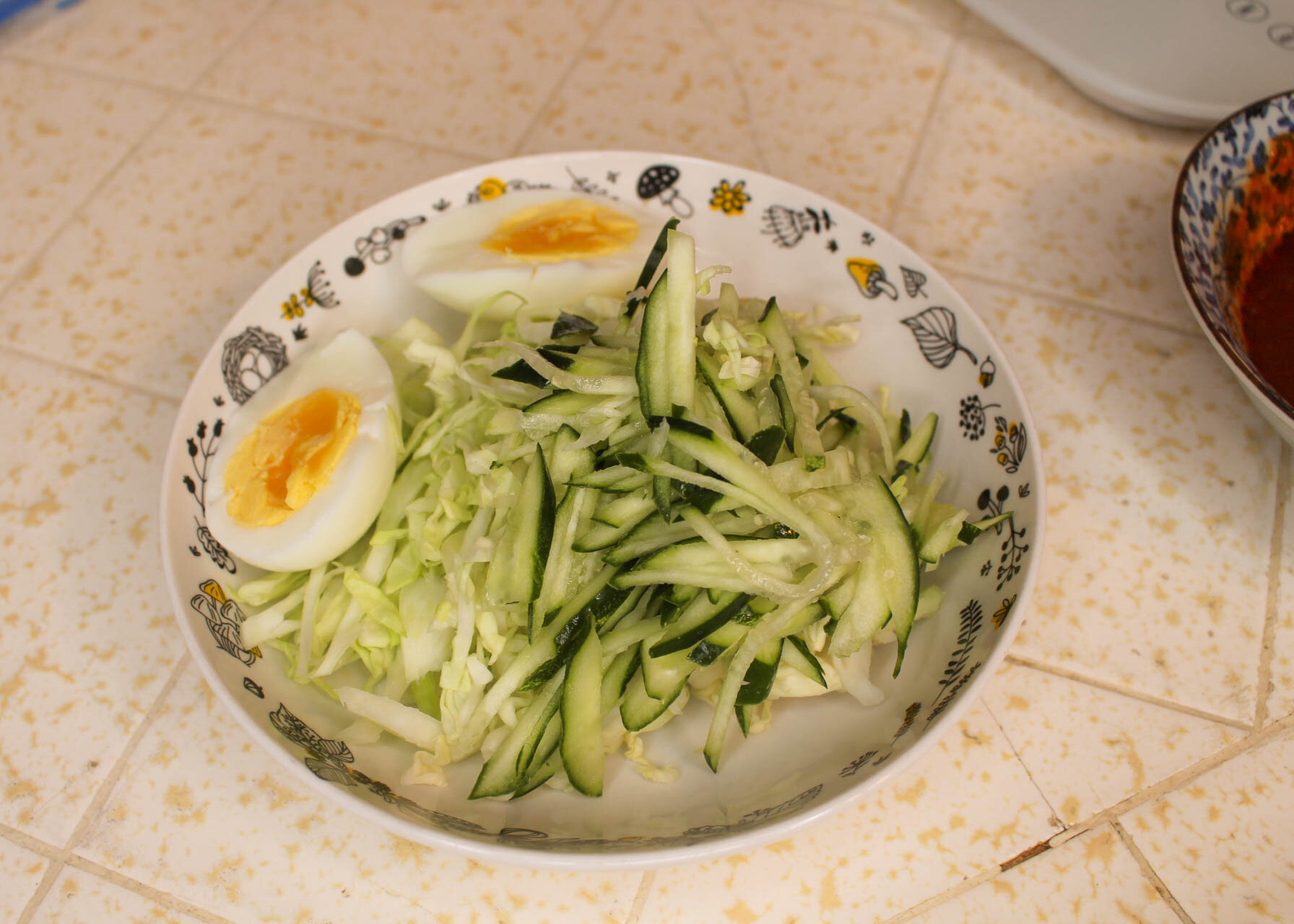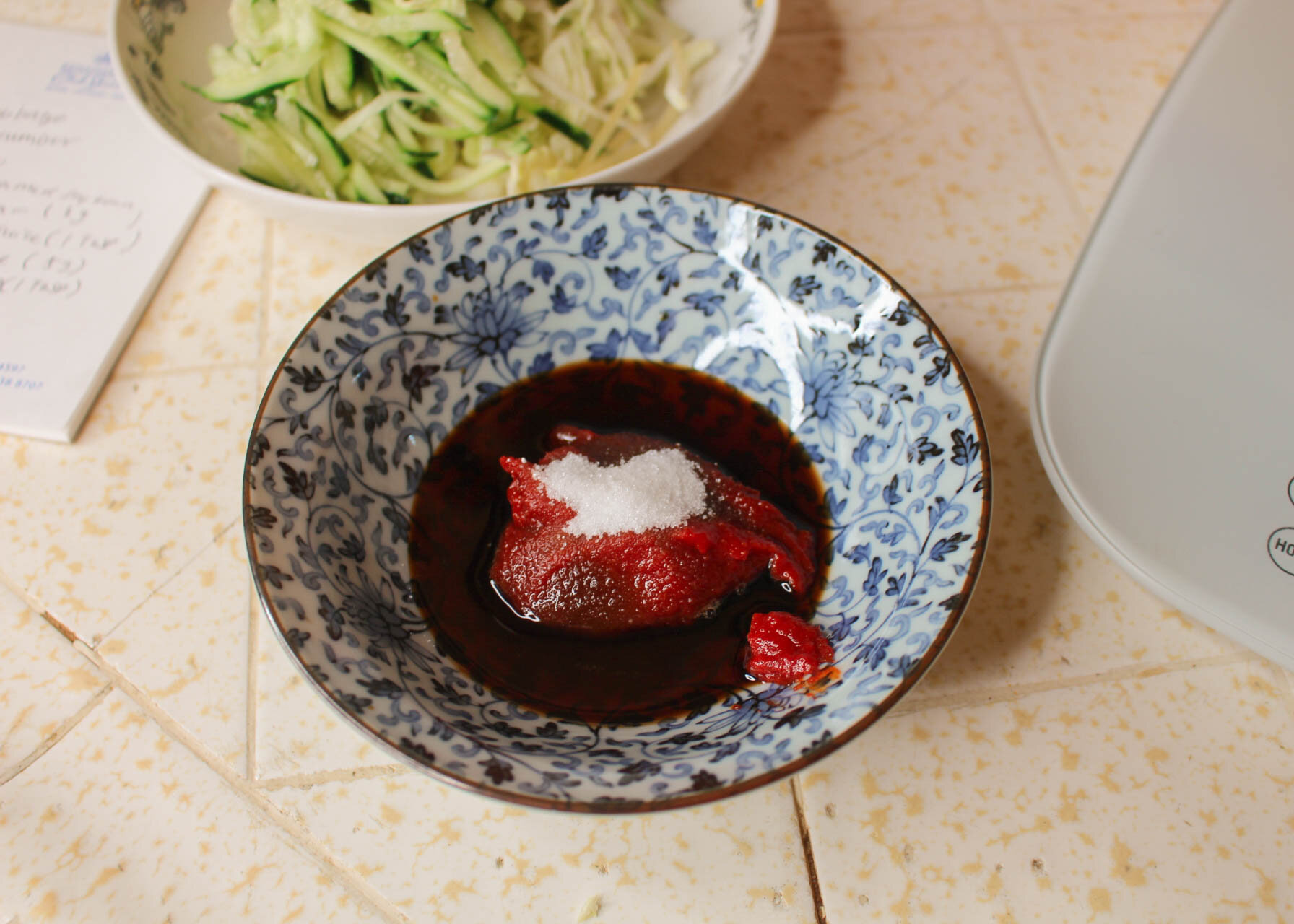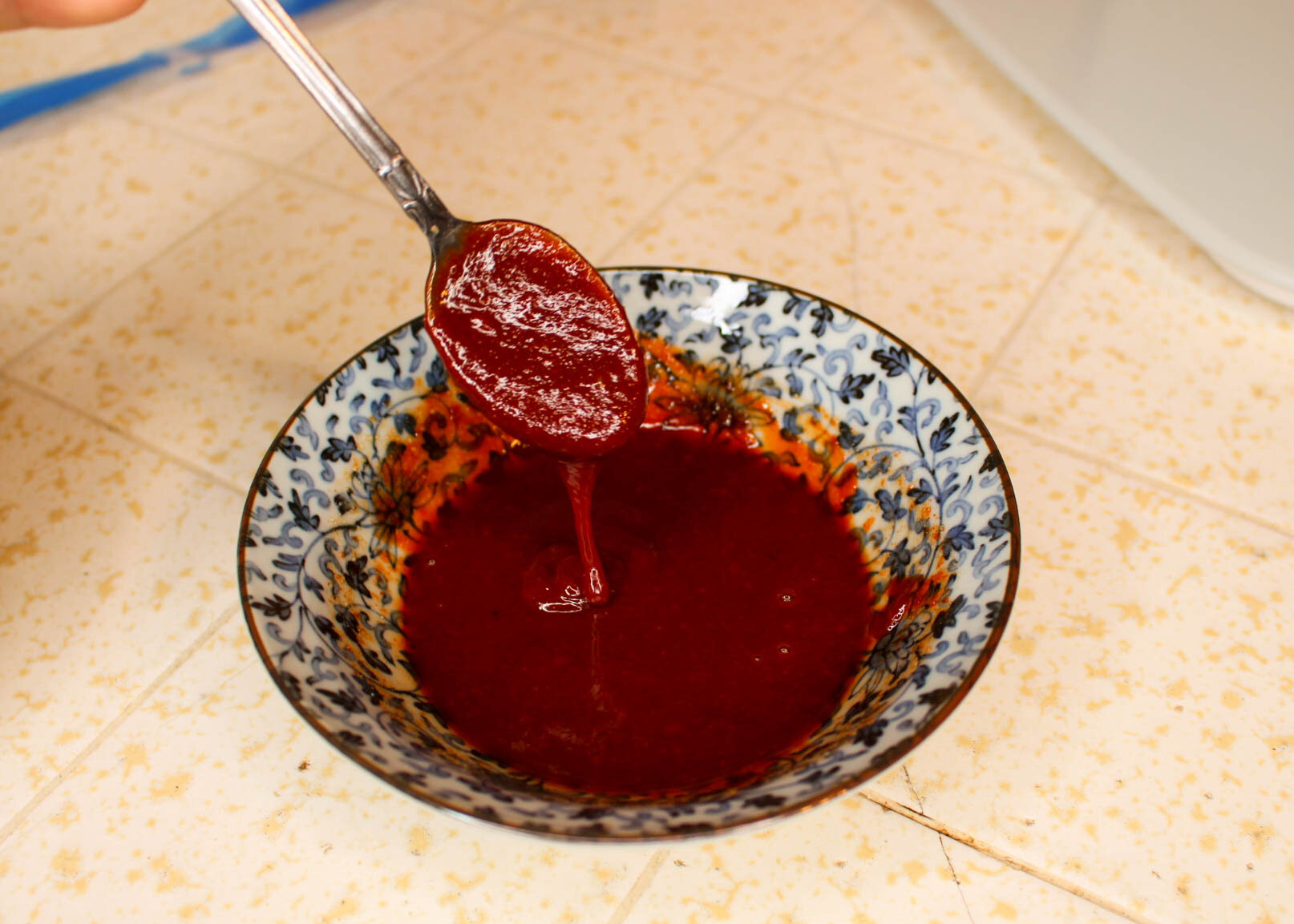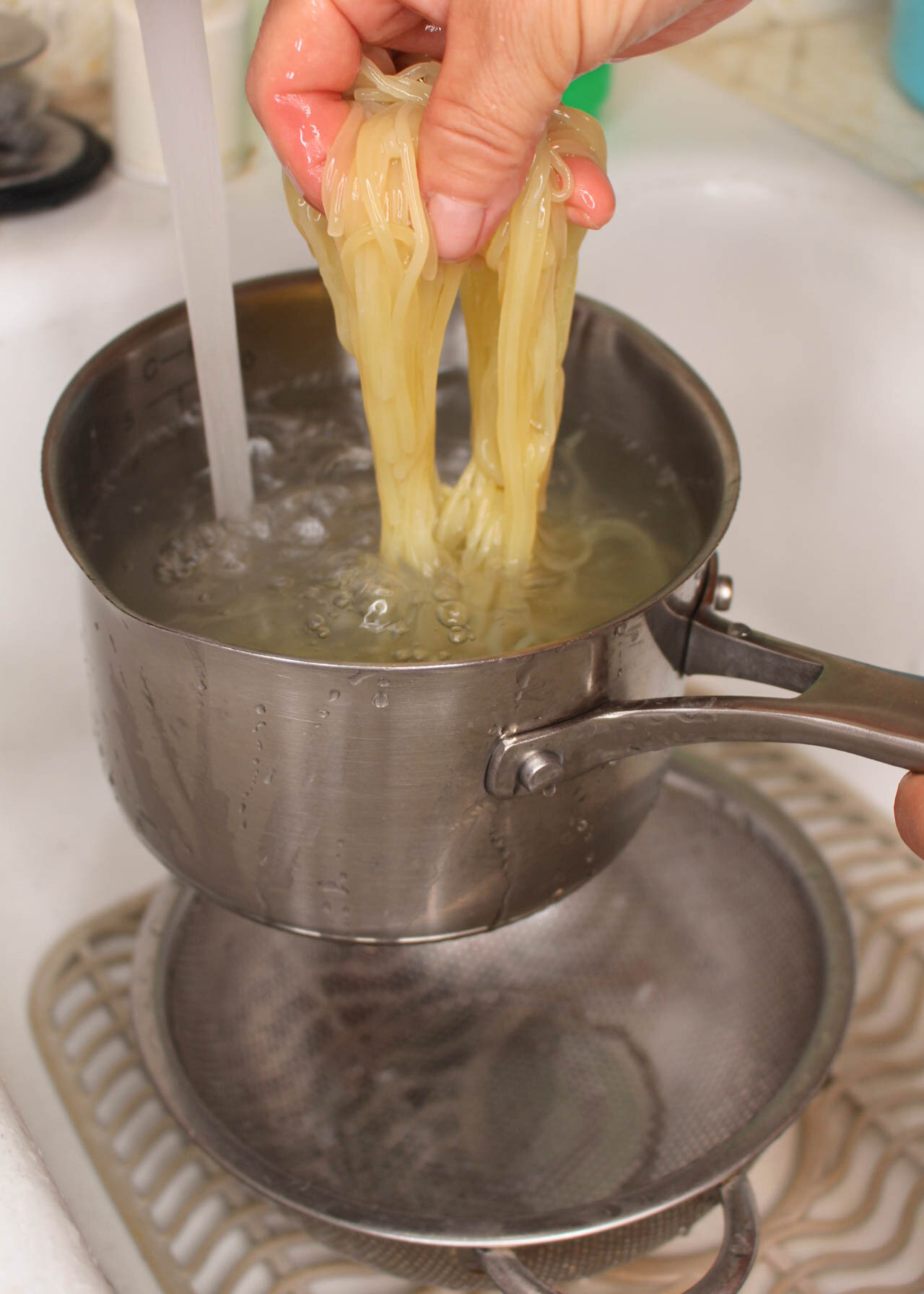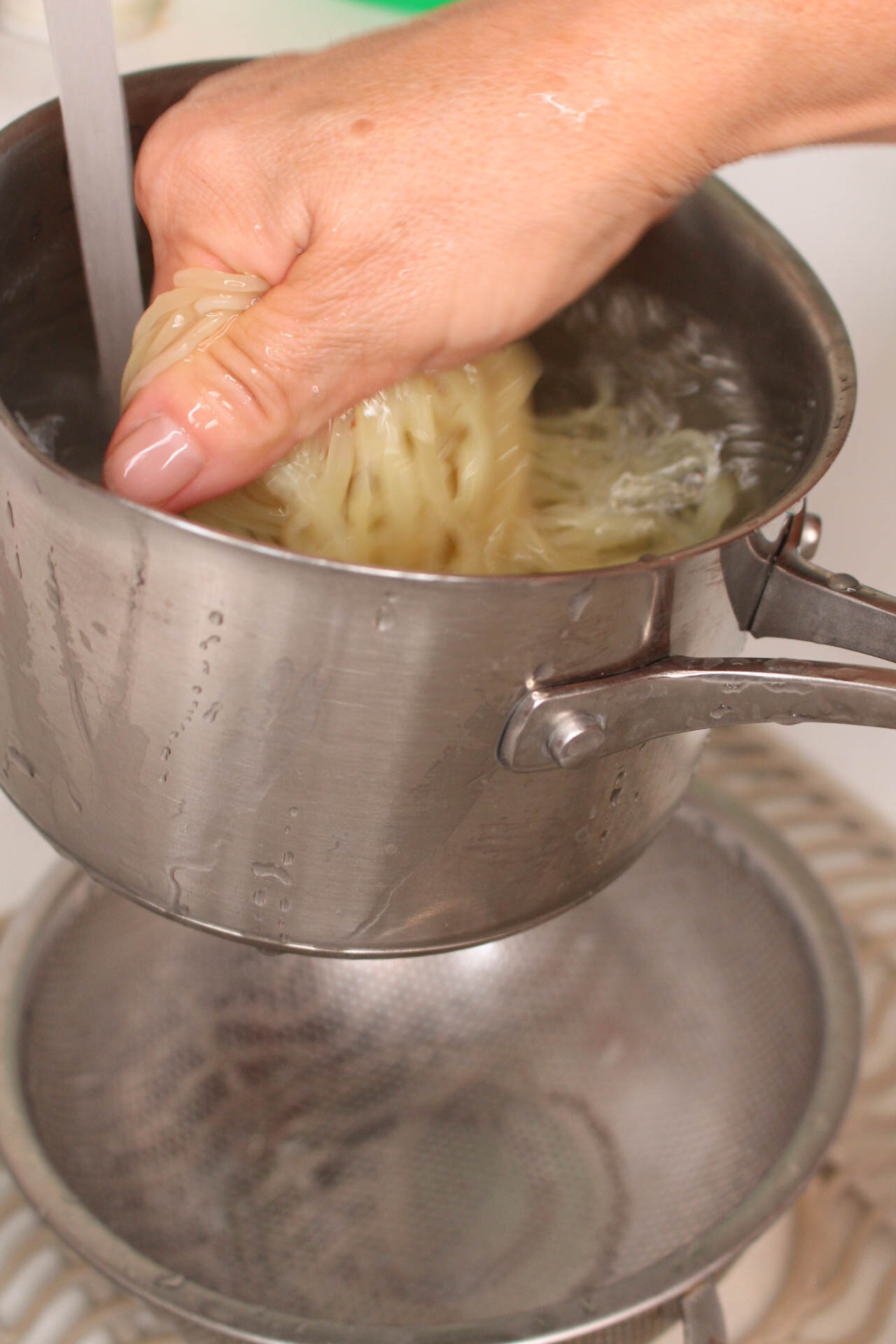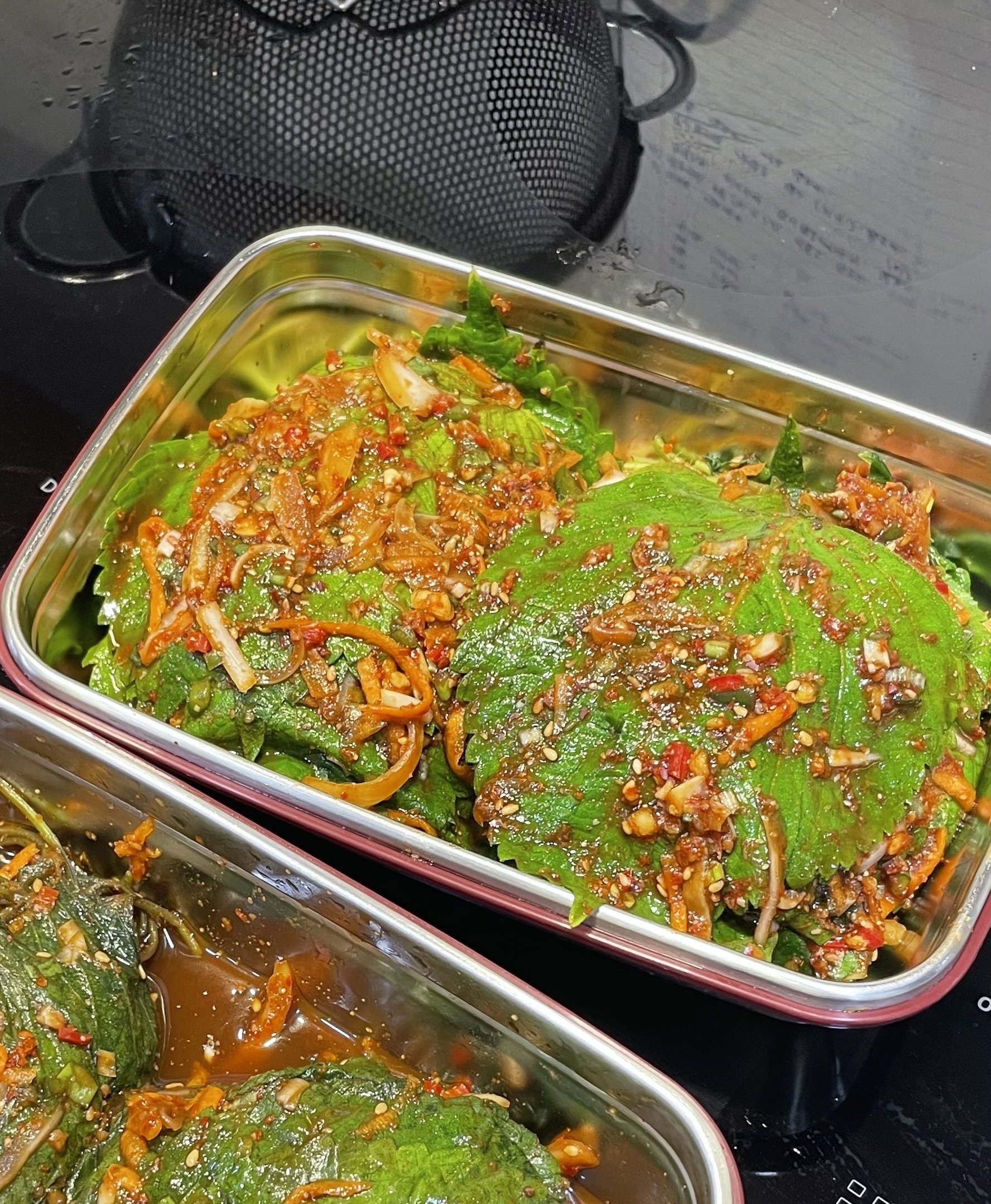Jjyolmyeon (Korean Spicy Noodles) - Quick & EASY | 쫄면
Pronounced: chyeul-myun
What: Jjolmyeon is a quick & spicy noodle dish with notes of gochujang (Korean red pepper paste), chewy wheat flour noodles, and flavors of classic Korean seasonings. It’s a cold noodle dish commonly eaten during hot summer days.
Taste: Strong gochujang (Korean red pepper paste) flavor, yet sweet and savory with hints of soy sauce, sesame oil, and more. Jam packed with a lot of vegetables that give it a good crunch.
How It’s Made: Chop vegetables. Steam soybean (optional). Make sauce. Boil noodles. Mix. Enjoy.
What to Serve it With: By itself!
Notes & Tips: You can find the noodles in the frozen section at the Korean grocery store. Here is a picture of the noodles we bought (ingredients is mainly wheat flour):

Jjyolmyeon (Korean Spicy Noodles) - Quick & EASY | 쫄면
Ingredients
- 123g frozen Korean chewy noodles* (see notes)
- Cabbage, thinly sliced (80g)
- 1 cucumber, thinly sliced (55g)
- 1 bag of Soybean sprouts (340g)
- Boiled egg, halved
- 1 & 1/2 tbsp plum extract syrup (We use Beksul brand)
- 1/2 tbsp soy sauce (We use regular Kikkoman brand)
- 1 heaping Tbsp of gochujang (25g) (We use Sempio brand)
- 1/2 Tbsp white sugar
- 1/2 tbsp + 1 tsp vinegar (We use apple vinegar by Ottogi brand. Rice and white vinegar is good too)
- 1/2 Tbsp sesame oil
- Sesame seeds for garnish
Instructions
- Prepare vegetables by cutting cabbage (80g) and 1 cucumber (55g) into thin slices. Cut boiled egg in half.
- Optionally, you can add steamed soybean sprouts (next step) to this dish as well, which I recommend. I didn’t have any when creating this dish at the time, but definitely would have added.
- To steam soybean sprouts: place about 1/2 cup of water into a pot and add entire package of soybean sprouts (340g). You shouldn’t be able to see the water—in other words, you don’t need much. Place on medium-high heat and cover with lid. Once it starts steaming, immediately remove from heat and strain out the water. Do NOT run under cold water. Let the steamed sprouts cool down, rotating it when one side cools down. Refrigerate to cool.
- Create sauce mixture by combining the following in a small bowl: 1 & 1/2 tbsp plum extract syrup (We use Beksul brand), 1/2 tbsp soy sauce (We use regular Kikkoman brand), 1 heaping Tbsp of gochujang (We use Sempio brand), and 1/2 Tbsp white sugar
- Boil water in a small pot. Add a fist size of frozen Korean noodles (123g) to boiling water. Separate noodles with chopsticks so they don’t stick together. Cook for 4 minutes (it took us exactly 3 minutes and 45 seconds)— be careful to NOT overcook! Increase heat if the frozen temperature of noodles stops the water from boiling.
- To test if noodles are fully cooked: noodles should be al dente in texture, yet chewy. It’s not soft like spaghetti noodles.
- Strain the noodles, and run it under cold water while spreading the noodles through your fingers to completely cool it down. Strain again, and squeeze out the excess liquids out of the noodles. Place noodles in serving bowl.
- To the serving bowl with noodles, add sauce mixture (in increments if you do not want to add all of it), chopped vegetables (desired amount, we put in A LOT), boiled egg (cut in half). We personally use up all the vegetables in this recipe, so we add the entire sauce mixture. Add more or less, completely up to your preference. If you have less vegetables, use less of the sauce mixture.
- Lastly, add the following to the top: 1/2 tbsp + 1 tsp vinegar (We use apple vinegar by Ottogi brand. Rice and white vinegar is good too), 1/2 Tbsp sesame oil, and sesame seeds to garnish
- Serve! To eat, mix it ALL up!
- Refrigerate any leftover steamed soybean sprouts. You can make a side dish with this called kongnamul muchim.
Notes:
Prepare vegetables by cutting cabbage (80g) and 1 cucumber (55g) into thin slices. Cut boiled egg in half.
Optionally, you can add steamed soybean sprouts to this dish as well, which I recommend. I didn’t have any when creating this dish at the time, but definitely would have added.
To steam soybean sprouts: place about 1/2 cup of water into a pot and add entire package of soybean sprouts (340g). You shouldn’t be able to see the water—in other words, you don’t need much. Place on medium-high heat and cover with lid. Once it starts steaming, immediately remove from heat and strain out the water. Do NOT run under cold water. Let the steamed sprouts cool down, rotating it when one side cools down. Refrigerate to cool.
Create sauce mixture by combining the following in a small bowl:
1 & 1/2 tbsp plum extract syrup (We use Beksul brand)
1/2 tbsp soy sauce (We use regular Kikkoman brand)
1 heaping Tbsp of gochujang (We use Sempio brand)
1/2 Tbsp white sugar
Boil water in a small pot. Add a fist size of frozen Korean noodles (123g) to boiling water. Separate noodles with chopsticks so they don’t stick together. Cook for 4 minutes (it took us exactly 3 minutes and 45 seconds)— be careful to NOT overcook! Increase heat if the frozen temperature of noodles stops the water from boiling.
To test if noodles are fully cooked: noodles should be al dente in texture, yet chewy. It’s not soft like spaghetti noodles.
Strain the noodles, and run it under cold water while spreading the noodles through your fingers to completely cool it down. It should be COLD noodles! Strain again, and squeeze out the excess liquids out of the noodles. Place noodles in serving bowl.
To the serving bowl with noodles, add sauce mixture (in increments if you do not want to add all of it), chopped vegetables (desired amount, we put in A LOT), boiled egg (cut in half). We personally use up all the vegetables in this recipe, so we add the entire sauce mixture. Add more or less, completely up to your preference. If you have less vegetables, use less of the sauce mixture.
Lastly, add the following to the top:
1/2 tbsp + 1 tsp vinegar (We use apple vinegar by Ottogi brand. Rice and white vinegar is good too)
1/2 Tbsp sesame oil
Sesame seeds for garnish
Serve! To eat, mix it ALL up!
Refrigerate any leftover steamed soybean sprouts. You can make a side dish with this called kongnamul muchim— I’ll link recipe here once I have it written up.
Enjoy!
